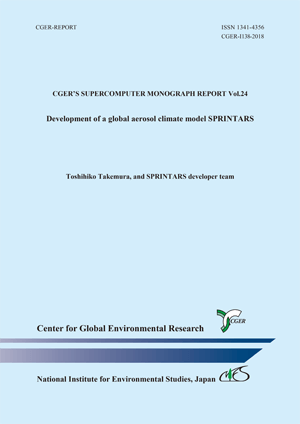TAKEMURA, T., AND SPRINTARS DEVELOPER TEAM
CGER Reports
CGER’s Supercomputer Monograph Report Vol. 24
Summary
Atmospheric aerosols affect not only visibility and human health but also the climate system generally through two interactions which perturb the radiation energy budget. One is the aerosol-radiation interaction in which aerosol particles scatter and absorb the solar and thermal radiation. The other is the aerosol-cloud interaction in which they change the microphysical, optical, and physical properties of cloud droplets and ice crystals acting as cloud condensation nuclei and ice nuclei. I have developed a global aerosol climate model, SPRINTARS (Spectral Radiation-Transport Model for Aerosol Species), coupled with a general circulation model, MIROC, to quantitatively evaluate the aerosol effects on the climate system. In SPRINTARS, the transport processes (emission, advection, diffusion, chemical reaction, and deposition) of major aerosol species in the troposphere are calculated to derive their global mass mixing ratios which are used in the radiation and cloud-precipitation schemes in MIROC.
This monograph is based on the following three papers.
- [Chapter 1] Takemura, T., H. Okamoto, Y. Maruyama, A. Numaguti, A. Higurashi, and T. Nakajima (2000) Global three-dimensional simulation of aerosol optical thickness distribution of various origins. J. Geophys. Res., 105, 17853–17873.
- [Chapter 2] Takemura, T., T. Nakajima, O. Dubovik, B. N. Holben, and S. Kinne (2002) Single-scattering albedo and radiative forcing of various aerosol species with a global three-dimensional model, J. Climate. 15, 333–352.
- [Chapter 3] Takemura, T., T. Nozawa, S. Emori, T. Y. Nakajima, and T. Nakajima (2005) Simulation of climate response to aerosol direct and indirect effects with aerosol transport-radiation model. J. Geophys. Res., 110, D02202, doi:10.1029/2004JD005029.
The aerosol processes of the transport, aerosol-radiation interaction, and aerosol-cloud interactions were developed in Takemura et al. (2000, 2002, 2005), respectively. In this monograph, the revised processes are included, as described in Takemura et al. (Atmos. Chem. Phys., 2009, doi:10.5194/acp-9-3061-2009), although the simulated results by older model versions remain in the comparisons with observations.
Several research achievements using SPRINTARS were cited by the 4th and 5th Assessment Reports of the Intergovernmental Panel on Climate Change (IPCC). SPRINTARS is participating in several international model intercomparison projects related to aerosols, e.g., AeroCom initiated in 2003 which is a primary contributor of estimating the aerosol effects on climate to the IPCC Assessment Reports. SPRINTARS is also incorporated into a global cloud resolving model, NICAM (e.g., Sato et al., Sci. Rep., 2016, doi:10.1038/srep26561) and applied to the 7-day aerosol forecast system (http://sprintars.net). I hope that SPRINTARS continues to be utilized for elucidating unclear scientific problems and supporting daily life.




 PDF, 13.6 MB
PDF, 13.6 MB